Abhinav Rastogi
Shammie
MoDE: Effective Multi-task Parameter Efficient Fine-Tuning with a Mixture of Dyadic Experts
Aug 02, 2024Abstract:Parameter-efficient fine-tuning techniques like Low-Rank Adaptation (LoRA) have revolutionized the adaptation of large language models (LLMs) to diverse tasks. Recent efforts have explored mixtures of LoRA modules for multi-task settings. However, our analysis reveals redundancy in the down-projection matrices of these architectures. This observation motivates our proposed method, Mixture of Dyadic Experts (MoDE), which introduces a novel design for efficient multi-task adaptation. This is done by sharing the down-projection matrix across tasks and employing atomic rank-one adapters, coupled with routers that allow more sophisticated task-level specialization. Our design allows for more fine-grained mixing, thereby increasing the model's ability to jointly handle multiple tasks. We evaluate MoDE on the Supernatural Instructions (SNI) benchmark consisting of a diverse set of 700+ tasks and demonstrate that it outperforms state-of-the-art multi-task parameter-efficient fine-tuning (PEFT) methods, without introducing additional parameters. Our findings contribute to a deeper understanding of parameter efficiency in multi-task LLM adaptation and provide a practical solution for deploying high-performing, lightweight models.
Improve Mathematical Reasoning in Language Models by Automated Process Supervision
Jun 05, 2024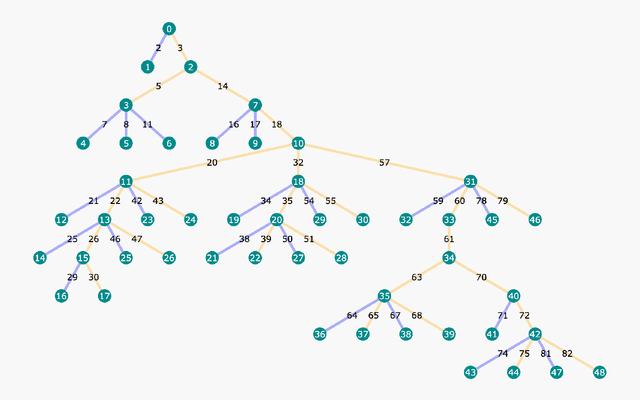

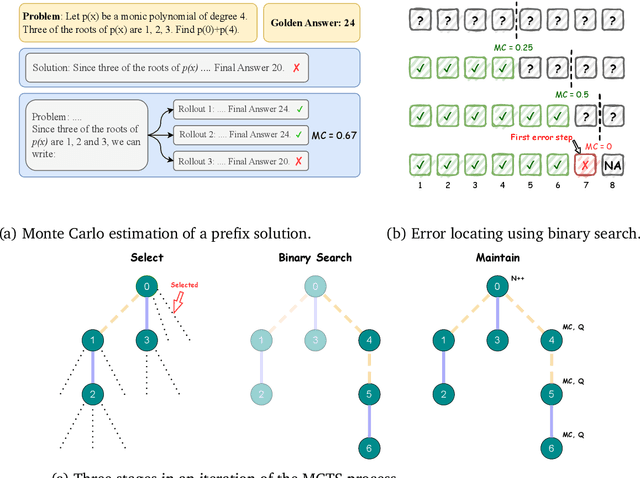
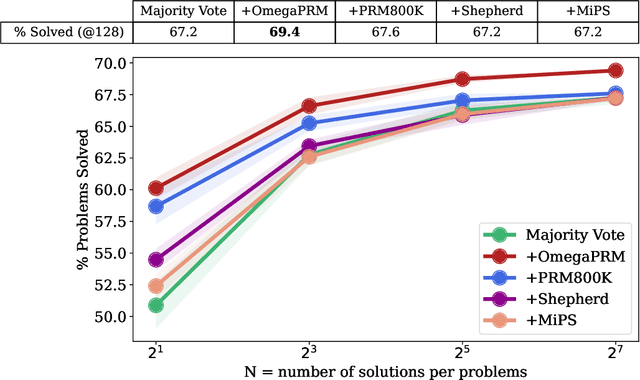
Abstract:Complex multi-step reasoning tasks, such as solving mathematical problems or generating code, remain a significant hurdle for even the most advanced large language models (LLMs). Verifying LLM outputs with an Outcome Reward Model (ORM) is a standard inference-time technique aimed at enhancing the reasoning performance of LLMs. However, this still proves insufficient for reasoning tasks with a lengthy or multi-hop reasoning chain, where the intermediate outcomes are neither properly rewarded nor penalized. Process supervision addresses this limitation by assigning intermediate rewards during the reasoning process. To date, the methods used to collect process supervision data have relied on either human annotation or per-step Monte Carlo estimation, both prohibitively expensive to scale, thus hindering the broad application of this technique. In response to this challenge, we propose a novel divide-and-conquer style Monte Carlo Tree Search (MCTS) algorithm named \textit{OmegaPRM} for the efficient collection of high-quality process supervision data. This algorithm swiftly identifies the first error in the Chain of Thought (CoT) with binary search and balances the positive and negative examples, thereby ensuring both efficiency and quality. As a result, we are able to collect over 1.5 million process supervision annotations to train a Process Reward Model (PRM). Utilizing this fully automated process supervision alongside the weighted self-consistency algorithm, we have enhanced the instruction tuned Gemini Pro model's math reasoning performance, achieving a 69.4\% success rate on the MATH benchmark, a 36\% relative improvement from the 51\% base model performance. Additionally, the entire process operates without any human intervention, making our method both financially and computationally cost-effective compared to existing methods.
PERL: Parameter Efficient Reinforcement Learning from Human Feedback
Mar 15, 2024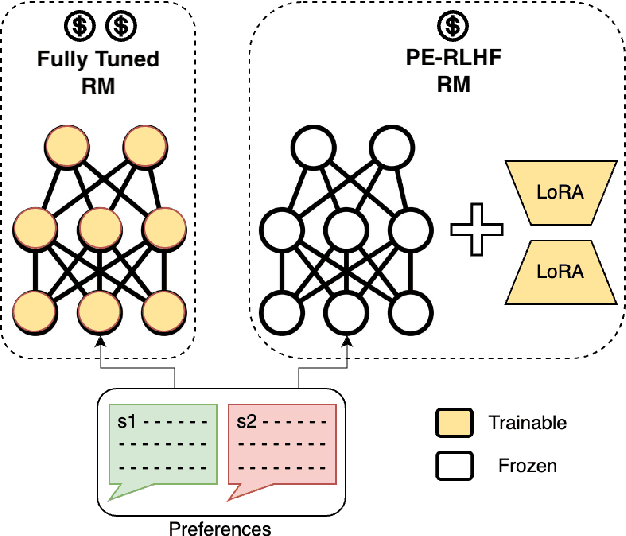
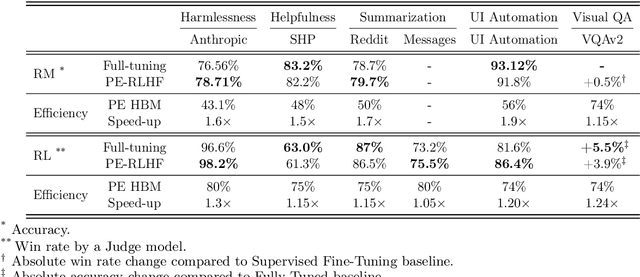
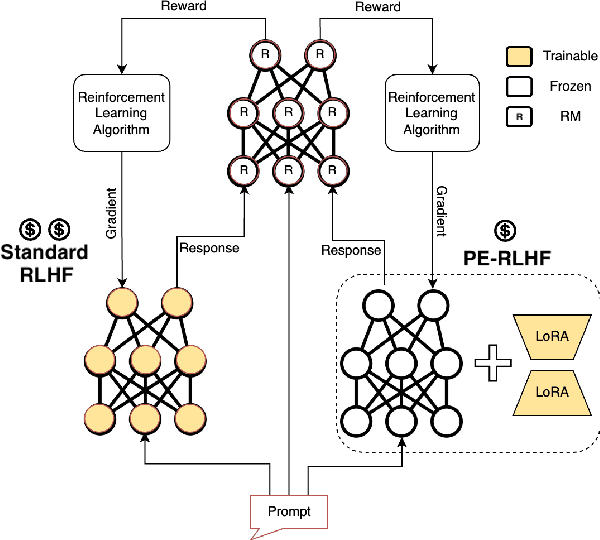
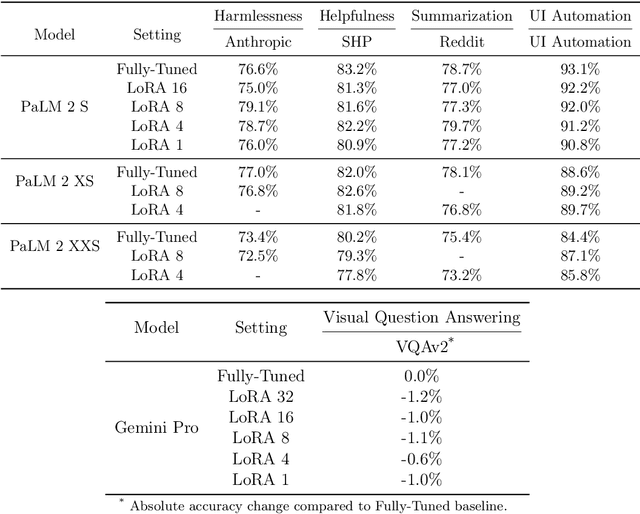
Abstract:Reinforcement Learning from Human Feedback (RLHF) has proven to be a strong method to align Pretrained Large Language Models (LLMs) with human preferences. But training models with RLHF is computationally expensive, and an overall complex process. In this work, we study RLHF where the underlying models are trained using the parameter efficient method of Low-Rank Adaptation (LoRA) introduced by Hu et al. [2021]. We investigate the setup of "Parameter Efficient Reinforcement Learning" (PERL), in which we perform reward model training and reinforcement learning using LoRA. We compare PERL to conventional fine-tuning (full-tuning) across various configurations for 7 benchmarks, including 2 novel datasets, of reward modeling and reinforcement learning. We find that PERL performs on par with the conventional RLHF setting, while training faster, and with less memory. This enables the high performance of RLHF, while reducing the computational burden that limits its adoption as an alignment technique for Large Language Models. We also release 2 novel thumbs up/down preference datasets: "Taskmaster Coffee", and "Taskmaster Ticketing" to promote research around RLHF.
RLAIF: Scaling Reinforcement Learning from Human Feedback with AI Feedback
Sep 01, 2023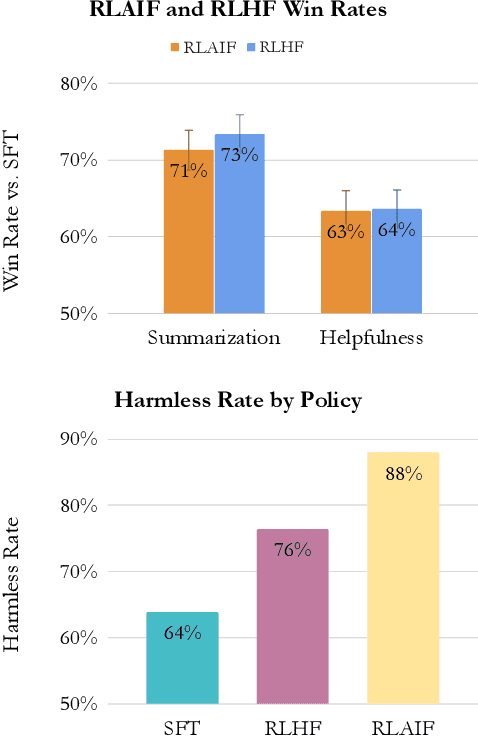
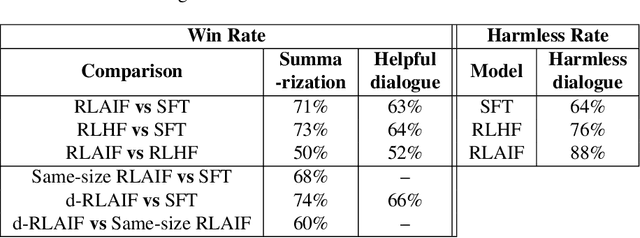
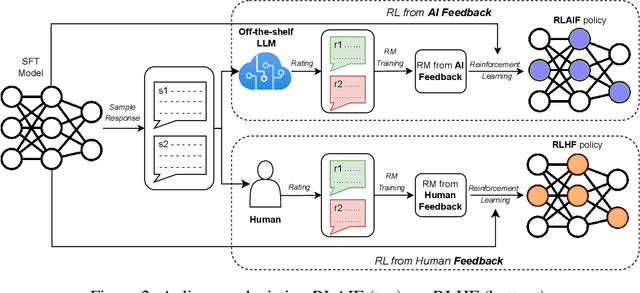

Abstract:Reinforcement learning from human feedback (RLHF) is effective at aligning large language models (LLMs) to human preferences, but gathering high quality human preference labels is a key bottleneck. We conduct a head-to-head comparison of RLHF vs. RL from AI Feedback (RLAIF) - a technique where preferences are labeled by an off-the-shelf LLM in lieu of humans, and we find that they result in similar improvements. On the task of summarization, human evaluators prefer generations from both RLAIF and RLHF over a baseline supervised fine-tuned model in ~70% of cases. Furthermore, when asked to rate RLAIF vs. RLHF summaries, humans prefer both at equal rates. These results suggest that RLAIF can yield human-level performance, offering a potential solution to the scalability limitations of RLHF.
Conversational Recommendation as Retrieval: A Simple, Strong Baseline
May 23, 2023Abstract:Conversational recommendation systems (CRS) aim to recommend suitable items to users through natural language conversation. However, most CRS approaches do not effectively utilize the signal provided by these conversations. They rely heavily on explicit external knowledge e.g., knowledge graphs to augment the models' understanding of the items and attributes, which is quite hard to scale. To alleviate this, we propose an alternative information retrieval (IR)-styled approach to the CRS item recommendation task, where we represent conversations as queries and items as documents to be retrieved. We expand the document representation used for retrieval with conversations from the training set. With a simple BM25-based retriever, we show that our task formulation compares favorably with much more complex baselines using complex external knowledge on a popular CRS benchmark. We demonstrate further improvements using user-centric modeling and data augmentation to counter the cold start problem for CRSs.
AnyTOD: A Programmable Task-Oriented Dialog System
Dec 20, 2022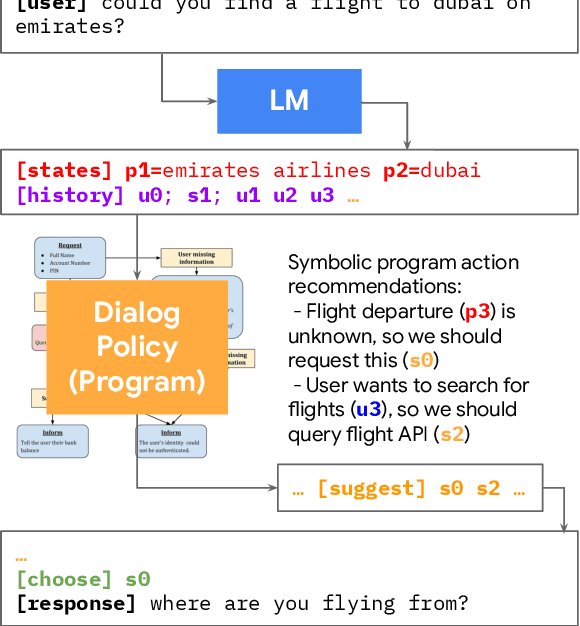
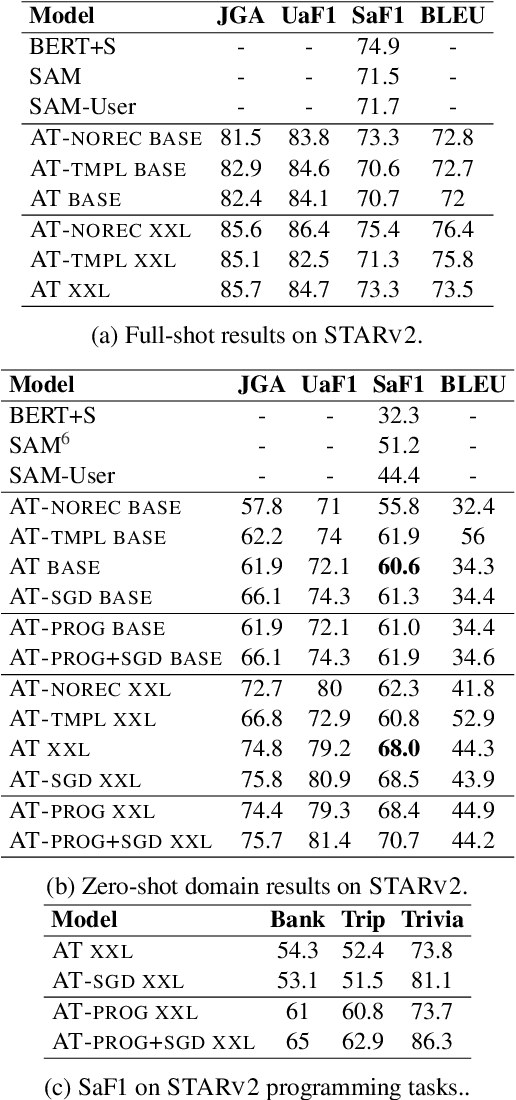
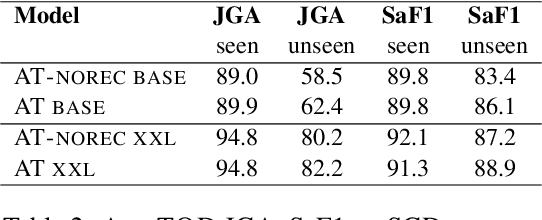
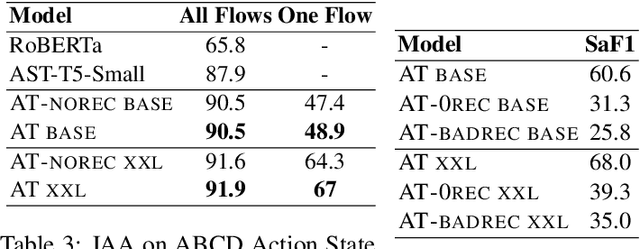
Abstract:We propose AnyTOD, an end-to-end task-oriented dialog (TOD) system with zero-shot capability for unseen tasks. We view TOD as a program executed by a language model (LM), where program logic and ontology is provided by a designer in the form of a schema. To enable generalization onto unseen schemas and programs without prior training, AnyTOD adopts a neuro-symbolic approach. A neural LM keeps track of events that occur during a conversation, and a symbolic program implementing the dialog policy is executed to recommend next actions AnyTOD should take. This approach drastically reduces data annotation and model training requirements, addressing a long-standing challenge in TOD research: rapidly adapting a TOD system to unseen tasks and domains. We demonstrate state-of-the-art results on the STAR and ABCD benchmarks, as well as AnyTOD's strong zero-shot transfer capability in low-resource settings. In addition, we release STARv2, an updated version of the STAR dataset with richer data annotations, for benchmarking zero-shot end-to-end TOD models.
Speech Aware Dialog System Technology Challenge (DSTC11)
Dec 16, 2022



Abstract:Most research on task oriented dialog modeling is based on written text input. However, users interact with practical dialog systems often using speech as input. Typically, systems convert speech into text using an Automatic Speech Recognition (ASR) system, introducing errors. Furthermore, these systems do not address the differences in written and spoken language. The research on this topic is stymied by the lack of a public corpus. Motivated by these considerations, our goal in hosting the speech-aware dialog state tracking challenge was to create a public corpus or task which can be used to investigate the performance gap between the written and spoken forms of input, develop models that could alleviate this gap, and establish whether Text-to-Speech-based (TTS) systems is a reasonable surrogate to the more-labor intensive human data collection. We created three spoken versions of the popular written-domain MultiWoz task -- (a) TTS-Verbatim: written user inputs were converted into speech waveforms using a TTS system, (b) Human-Verbatim: humans spoke the user inputs verbatim, and (c) Human-paraphrased: humans paraphrased the user inputs. Additionally, we provided different forms of ASR output to encourage wider participation from teams that may not have access to state-of-the-art ASR systems. These included ASR transcripts, word time stamps, and latent representations of the audio (audio encoder outputs). In this paper, we describe the corpus, report results from participating teams, provide preliminary analyses of their results, and summarize the current state-of-the-art in this domain.
Beyond the Imitation Game: Quantifying and extrapolating the capabilities of language models
Jun 10, 2022Abstract:Language models demonstrate both quantitative improvement and new qualitative capabilities with increasing scale. Despite their potentially transformative impact, these new capabilities are as yet poorly characterized. In order to inform future research, prepare for disruptive new model capabilities, and ameliorate socially harmful effects, it is vital that we understand the present and near-future capabilities and limitations of language models. To address this challenge, we introduce the Beyond the Imitation Game benchmark (BIG-bench). BIG-bench currently consists of 204 tasks, contributed by 442 authors across 132 institutions. Task topics are diverse, drawing problems from linguistics, childhood development, math, common-sense reasoning, biology, physics, social bias, software development, and beyond. BIG-bench focuses on tasks that are believed to be beyond the capabilities of current language models. We evaluate the behavior of OpenAI's GPT models, Google-internal dense transformer architectures, and Switch-style sparse transformers on BIG-bench, across model sizes spanning millions to hundreds of billions of parameters. In addition, a team of human expert raters performed all tasks in order to provide a strong baseline. Findings include: model performance and calibration both improve with scale, but are poor in absolute terms (and when compared with rater performance); performance is remarkably similar across model classes, though with benefits from sparsity; tasks that improve gradually and predictably commonly involve a large knowledge or memorization component, whereas tasks that exhibit "breakthrough" behavior at a critical scale often involve multiple steps or components, or brittle metrics; social bias typically increases with scale in settings with ambiguous context, but this can be improved with prompting.
Show, Don't Tell: Demonstrations Outperform Descriptions for Schema-Guided Task-Oriented Dialogue
Apr 08, 2022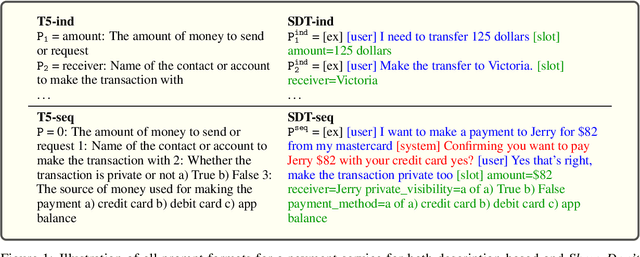
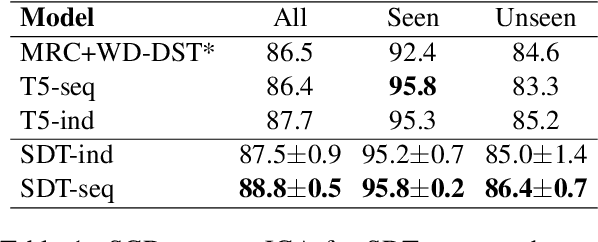
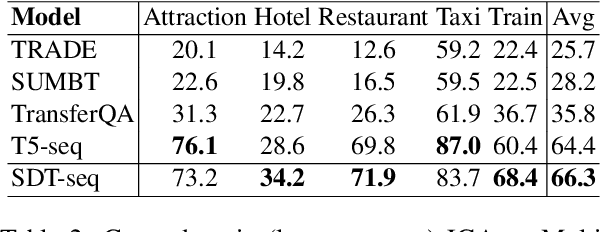

Abstract:Building universal dialogue systems that can seamlessly operate across multiple domains/APIs and generalize to new ones with minimal supervision and maintenance is a critical challenge. Recent works have leveraged natural language descriptions for schema elements to enable such systems; however, descriptions can only indirectly convey schema semantics. In this work, we propose Show, Don't Tell, a prompt format for seq2seq modeling which uses a short labeled example dialogue to show the semantics of schema elements rather than tell the model via descriptions. While requiring similar effort from service developers, we show that using short examples as schema representations with large language models results in stronger performance and better generalization on two popular dialogue state tracking benchmarks: the Schema-Guided Dialogue dataset and the MultiWoZ leave-one-out benchmark.
A Unified Approach to Entity-Centric Context Tracking in Social Conversations
Jan 28, 2022



Abstract:In human-human conversations, Context Tracking deals with identifying important entities and keeping track of their properties and relationships. This is a challenging problem that encompasses several subtasks such as slot tagging, coreference resolution, resolving plural mentions and entity linking. We approach this problem as an end-to-end modeling task where the conversational context is represented by an entity repository containing the entity references mentioned so far, their properties and the relationships between them. The repository is updated turn-by-turn, thus making training and inference computationally efficient even for long conversations. This paper lays the groundwork for an investigation of this framework in two ways. First, we release Contrack, a large scale human-human conversation corpus for context tracking with people and location annotations. It contains over 7000 conversations with an average of 11.8 turns, 5.8 entities and 15.2 references per conversation. Second, we open-source a neural network architecture for context tracking. Finally we compare this network to state-of-the-art approaches for the subtasks it subsumes and report results on the involved tradeoffs.
 Add to Chrome
Add to Chrome Add to Firefox
Add to Firefox Add to Edge
Add to Edge